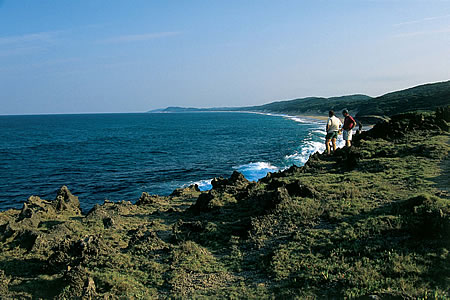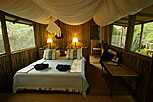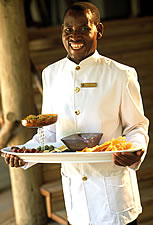![]()
South Africa's Eastern Cape

Vacationtechnician personalized luxury adventure travel transports you to the most exquisite wilderness and chill out retreats on Earth. Conserving rare biodiversity through low volume tourism; our aim is your indulgence -at no one's expense. Plan now to be assured a rejuvenating escape at a restful pace -to an unspoilt gem in the purest sense.
Revelling in the luxury of Kwandwe beside his private swimming pool next to the Great Fish River, vacationtechnician recalls the morning's game drive and elephants ambling across the spekboom-covered hills, rhinos on the rocky plains, flowering succulents, the roar of a lion from a kloof. Birds are calling quietly in the distance and acacia blossoms stretch away in fields of yellow. A scrunch of gravel announces the arrival of my personal butler, neatly dressed, with a tray of fresh fruit, Camembert cheese, homemade brown bread and a bottle of chilled Cape wine ... such is life on the Wild Frontier.
Ten years ago, visitors to the Eastern Cape in South Africa would not have dreamed that the region could offer anything like the luxury lodges and thrilling game-viewing that were par for the course in the private game reserves bordering the Kruger National Park. But times have changed.
The transition from private farming to tourism-based conservation in what has traditionally been an economically depressed part of South Africa has been swift and sure. Much of the credit must go to Port Elizabeth businessman Adrian Gardiner, who established Shamwari Game Reserve in the 1990s and began marketing the Eastern Cape to international tourists. One of his trump cards was that the area, unlike the Lowveld around the Kruger Park, is malaria free, and the notion that it was possible to set up reserves for big game with this decided advantage encouraged other landowners to follow Gardiner's lead.
Another player in the transition is the Wilderness Foundation, an NGO that has based itself in the Eastern Cape near Shamwari because it regards the region as South Africa's new wilderness frontier. Originated by Dr Ian Player and now run by Andrew Muir, the Foundation is closely involved in creating the 500000-hectare Baviaanskloof mega-reserve in the western part of the province, but much of its effort is also going into areas closer to home.
One of its most interesting tasks is steering the activities of the Eastern Cape Private Nature Reserve Association, or Indalo, which is guiding the development and game-management practices of local reserves. According to studies conducted by the University of Port Elizabeth, 180 reserves in the region are now involved in some way with wildlife. Some are hunting areas managed by their own controlling institutions, but there are also many farmers who are getting into the tourism market for the first time and have yet to learn how best to manage their land for its new use and how to promote their enterprise.
Indalo has seven founding members, each with more than 2 000 hectares under conservation and each with photographic safaris as its main activity. They range from the likes of Amakhala (where five families whose origins go back to the 1820 Settlers have dropped their fences to form a conservancy) to Kwandwe and Shamwari, which employ their own ecologists as well as tourism advisors. Other members, like Lalibela, traditionally focused on hunting but have now also joined the swelling and profitable ranks of the photographic safari operator.
Even with new ventures springing up all around, Shamwari is still the flagship reserve of the Eastern Cape. It covers 20 000 hectares of land, operates six lodges, employs over 300 staff, runs 20 game-drive vehicles and has its own ecological unit, museum, day centre and sanctuary for orphaned big cats. The reserve has been stocked with the Big Five and trained guides make sure that visitors see most of them. Among a host of other accolades, Shamwari has garnered World Travel Awards for five consecutive years as the world's leading conservation company and world's leading safari and game reserve.
All in all, Shamwari offers guests wildlife with luxury - and without. Thanks to the persuasive influence of Ian Player and Andrew Muir, some 3 000 hectares of former farmland have been cleared of all fences, buildings and roads, and set aside for wilderness trails. I tried one of these and, with only a water bottle, spoon, cup, plate, groundsheet and sleeping bag, set off into the hills with a guide and seven other walkers to experience the world as it was meant to be.
'It will not be easy walking in the wilderness - nor should it be,' Player had promised. 'But it will be rewarding and ultimately a spiritual experience.'
Alcohol was not permitted and the only luxury was coffee with powdered milk. Lunch was dried nuts and fruit, and dinner rice and Toppers. During the day the subject of conversation often turned to our oneness with the earth and how important it is to preserve areas that are untouched by man. Taking my turn to guard the campfire at night, I sat alone and pondered that many great spiritual men, including Jesus, Mohammed and Buddha, had spent time in the wilderness to come closer to their inner truths. It is this cleansing experience that is achieved most successfully on the trail.
Ultimately, though, most people who come to the Eastern Cape are overseas tourists and are not disposed to sitting in the dust and eating from a tin plate. Rather, their sights are set on a Hemingway experience that includes sundowners, the Big Five and vast Serengeti-type plains peppered with thorn trees.
Historically the Eastern Cape was blanketed by Thicket, a vegetation type dominated by spekboom, aloes and succulents, and the animals that occurred naturally - elephant, black rhino, bushbuck - were strong enough or small enough to bulldoze or squeeze through the thick, thorny vegetation. Much of the landscape has since been transformed by farming and it is in these cleared areas that private game reserves such as Shamwari have created the sought-after Serengeti-type game-viewing opportunities - complete with extra-limital species that include giraffe, white rhino and impala.
Although scientists voice their concern about the impact of these species, landowners maintain that these animals have a tremendous tourism value and they will continue to stock them for as long as they have no negative impact on the vegetation. It's far from being a perfect situation but these are businesses - and better to see a few vagrant impala than a golf course! On the plus side, lodges have created thousands of new jobs and have instigated the removal of kilometres of fencing and the eradication of alien plants such as prickly pear and jointed cactus. They are also helping to fund scientific research, including studies that monitor the impact of the extra-limital species.
In addition to Thicket, the vegetation types of Succulent Karoo, Nama Karoo, Fynbos, Grassland and Forest are all represented in the Eastern Cape, giving the province a tally of six out of seven of South Africa's biomes. Add year-round rainfall to the mix and the result is a mosaic of species so interwoven that it provides endless confusion - and fascination - for botanists, entomologists and nature lovers.
The core of conservation for the region is the Greater Addo Elephant National Park, administered by South African National Parks (SANParks). Still being consolidated, it will cover almost 400000 hectares from the arid Karoo in the north to Alexandria near the coast and encompass the Zuurberg Mountains and the original Addo Elephant National Park. With the challenge for many conservationists today being to protect entire habitats rather than single species, the new park is designed to include gradients and corridors that will help conserve vegetation threatened by, amongst other things, climatic change.
Two concessions, Gorah and Nyati, have been granted within the park boundaries, and private safaris are conducted through them. Gorah lies in the game-rich southern foothills of the original Addo Elephant National Park, where much of the surrounding area is fairly open as a result of having been farmed. From the deck of my lavishly decorated tent and from the restored farmhouse's verandah I could see elephant, zebra, hartebeest and even buffalo. A game drive was even more productive - we had six black rhino sightings in less than two hours.
Further north, Nyati Concession lies on the slopes of the spectacular Zuurberg. Traversing rights have been granted to River Bend, an established country house that has a swimming pool and spa, lush country gardens and its own small game reserve. SANParks intends to re-introduce buffalo, black rhino and elephant later this year, by which time River Bend will have removed fences, put in waterholes and moved extra-limital species to an adjoining 15 000-hectare conservancy. Its manager, Rob Pattie, also plans to stock giraffe, hippo, eland, brown hyaena, cheetah and ultimately lion, and five wild dogs from Hoedspruit are part of the ambitious plan.
In the Great Fish River region near Grahamstown, the leading role in private conservation is taken by Kwandwe, with its riverside chalets, private butlers and generous hospitality. Its 18 000 hectares are expertly run by Conservation Corporation Africa on behalf of American millionaire Carl DeSantis and wildlife management expert Angus Sholto-Douglas.
The environment here is more arid than that of the Addo region, but the spekboom-cloaked hills have been stocked with more than 7 000 animals and support concentrations of elephant and black rhino. Buffalo also starred in our day outings, while night drives were arranged to catch sight of more unusual species such as aardwolf and aardvark.
Sholto-Douglas says that running a game reserve in the Eastern Cape has been a real learning experience, and admits that one of the mistakes he made was stocking impala as a food source for the lions. It turned out that the predators preferred to hunt the naturally occurring species, so he now has to catch the impala and remove them to more suitable areas. Kwandwe has a sound and responsible conservation record - but it remains to be seen whether white rhino and giraffe will survive in this part of the Eastern Cape in the longer term.
One evening at Kwandwe our night drive was brought to a close by an elegantly presented bush dinner at which appropriately dressed actors recalled the history of those doughty English pioneers, the 1820 Settlers. The star of the show was resident historian Alan Weyer, one half of the 'Boet and Swaer' story-telling team whose uproarious conversations between two Eastern Cape farmers chatting over a fence has had people laughing all the way from London to Ladismith.
Weyer also tells a great story about things historical, and the following morning I joined him on a tour through the spectacular Double Drift Nature Reserve on a quest to learn about the Frontier Wars, waged here between the Xhosa and the Settlers in the 19th century. At midday we were atop Grahamstown's Signal Hill, where we imagined the Settlers arriving fresh from the boats to set up their farms in the veld. We also thought of the Xhosa chief Makuni and thousands of spear-brandishing warriors taking on in vain the heavily armed British in the garrison town. This is the stuff of books and drama, and just begs to be explored further.
Kariega, a 5 000-hectare private game reserve in the heart of Frontier Country
near Kenton-on-Sea, was my final stop. After a game drive, a boat trip and
finally a dip in the clear, warm waters of the Indian Ocean, I lay back in
the hot spa bath in my log cabin and reflected on my experiences in the rapidly
transforming Eastern Cape. I was sorry I hadn't seen the remaining 50 or so
game reserves, but the big game, friendly people, spectacular scenery, colourful
history, good roads and, above all, the optimistic and pioneering conservation
spirit I had experienced were proof enough that the area has a real edge.
Some of the lodges have had 100 per cent occupancy for several months at a
time - and, quite frankly, I am not surprised.
South Africa Reading
South Africa's Biotic
Wealth
South Africa:
Kruger National Park
Garden Route Activities
The Garden Route
Wild Frontier -Eastern Cape
The Wild Coast
Namaqualand
Namaqualand and more
Greater Addo National Park
Ndumo Game Reserve
HLUHLUWE-UMFOLOZI PARK
The Lowveld –Birding
ADDO ELEPHANTS
Drakensburg UNESCO World
Heritage Site
---------------------------------------------------
Listening • Understanding •Planning
Introduce Yourself -
Scheduled Trips - Private Safaris
- Newsletter
About Us - Our Mission
- Our Philosophy - Yacht
Charter - DryGoods
![]() We speak English
We speak English
![]() Wir sprechen Deutsch
Wir sprechen Deutsch
![]() On parle français
On parle français
![]() Parliamo italiano
Parliamo italiano
info at vacationtechnician dot com
Thanks for visiting vacationtechnician.com
Friendly•Dependable•Knowledgeable•Experienced
© 1998-2007 vacationtechnician.com All Rights Reserved




